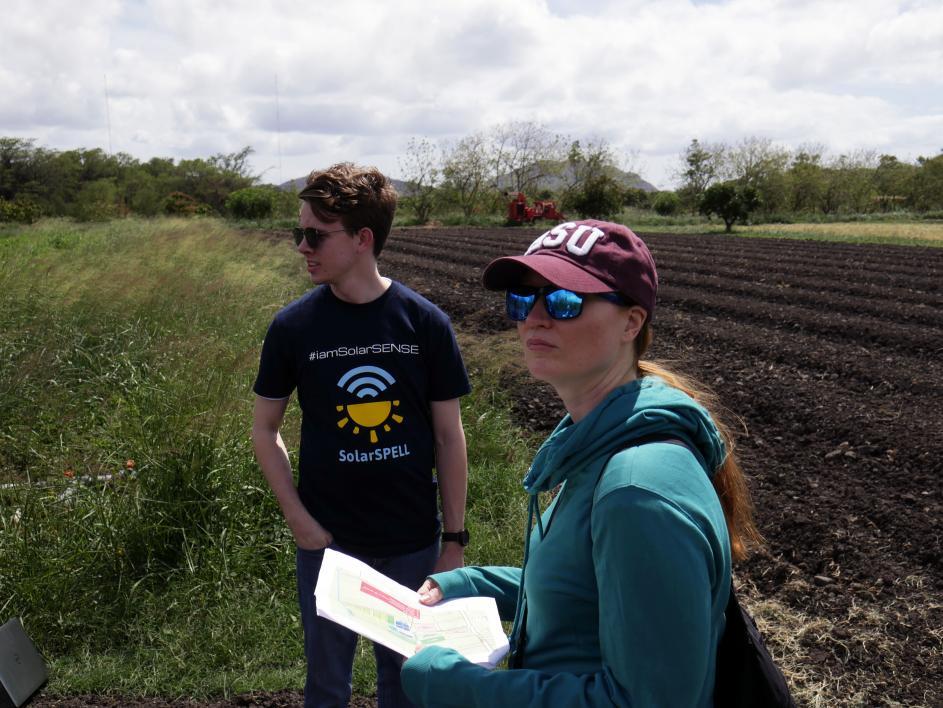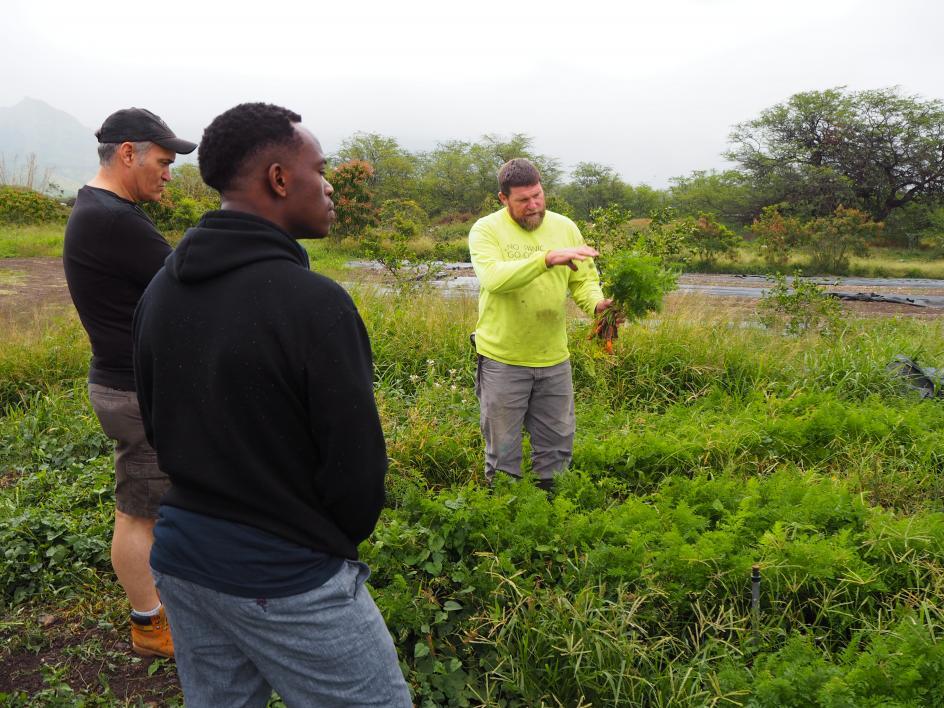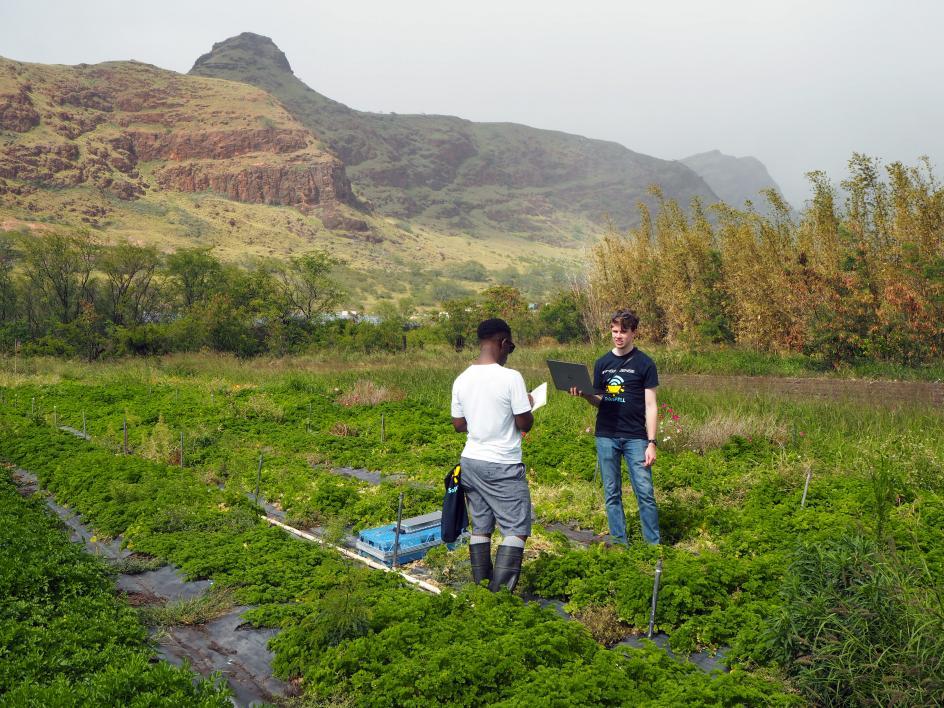ASU students developing off-grid tech to help small farms build resilience to climate change

With a growing global population, farmers are working hard to feed the world. Throw climate change into the mix and maintaining a thriving, high-yield farm becomes even harder.
Facing these challenges, it’s important for farmers to monitor soil for conditions such as temperature and moisture level in order to keep crops healthy. Agricultural sensors make it easy for farmers to take these measurements, but the sensors are usually attainable only for industrial farms that can afford the technology and can access electricity and a network connection. Rural small farms don’t always have these luxuries, said Bruce Baikie, a senior sustainability fellow in the Julie Ann Wrigley Global Institute of Sustainability at Arizona State University.
But the world can’t afford for small farms to fail. Family-run farms produce more than 80 percent of the world’s food, according to a 2014 report by the Food and Agriculture Organization. These farmers need a low-infrastructure, affordable way to keep up with changing conditions in their soils.
That’s where SolarSENSE, an ASU student capstone project sponsored by Baikie, comes in. SolarSENSE makes use of technology from SolarSPELL, Solar-Powered Educational Learning Libraries developed by Senior Sustainability Scientist Laura Hosman, to allow off-grid rural farms access to soil data from sensors without the need for electricity or costly internet connections.
The project, which started in September 2018 and currently involves five computer science seniors, is in its beginning stages. In early March, four of the students along with Baikie and HosmanHosman is also an associate professor in the School for the Future of Innovation in Society and the Polytechnic School, part of the Ira A. Fulton Schools of Engineering. traveled to Hawaii to test their innovative system on a remote farm — MA'O Organic Farms on the western side of Oahu (a connection arranged by Amanda Ellis, executive director of Hawaii and Asia Pacific in the ASU Wrigley Institute). Throughout their three-day proof-of-concept trip, the team also worked with the farmers to find out how SolarSENSE can take the data and present it in a way that is most useful.
In Hawaii, the team found that the technology worked, but they learned a lot about the product’s in-the-field application by interacting with the farmers.
“When we got into the field, we had to throw out the window a lot of preconceived notions we had and listen to the farmers,” Baikie said. “It helped point us in a new direction.”
Flame Porter, farm apprentice at MA'O Organic Farms, had positive feedback for SolarSENSE: "If we didn't care about our soil, we wouldn't be at this capacity. To be able to put (a sensor) in the soil and get results within that same day — it's revolutionary. It's going to help a lot of people.”
Ultimately, the goal of SolarSENSE is to not only improve accessibility to agricultural sensors for smaller farms, but also to connect the farmers to an agricultural library of recommended actions they could take based on the readings. The SolarSENSE digital agricultural library has both actional videos for farmers and a wealth of plant, soil and climate change information. The library is also accessed directly off the SolarSPELL unit — no internet connection required.
Kevin Hale, an ASU senior in software engineering who is part of the capstone team, said that they want the farmers to be able to “learn and share that knowledge with their community, so everyone can benefit.”
On a personal level, working with SolarSENSE has gone far beyond technology for Hale, who said that he learned a lot about sustainability and community through the Hawaiian farmers. One concept in particular that stuck with him was ahupua'a, the ancient Hawaiian system of land division to form self-sustaining ecosystems.
“The idea was that everyone helped each other get the resources that they need and that everyone supported each other locally,” Hale said. “I really enjoyed my time on the farm and seeing how the farmers too incorporated this mentality into their work. (I learned) that I need to not only worry about myself, but also look for ways that I can help sustain others in my community. Having these experiences … made me realize that I can have more impact on the world than I previously thought.”
The other ASU students involved in SolarSENSE for the fall 2018 and spring 2019 semesters are Tresor Cyubahiro, Wesley Davis, James Ortner and Scott Watkins. While in Hawaii, the team met with University of Hawaii President David Lassner to identify opportunities for collaboration between the two universities, and Hosman presented early findings about SolarSENSE testing at MA'O Organic Farms at a Sustainability Leaders Series event jointly sponsored by the ASU Wrigley Institute and the East-West Center.
Julie Ann Wrigley noted: “This is exactly the kind of practical impact I am proud our ASU Wrigley Institute sustainability scientists are able to make in the field. I am thrilled to see the wonderful work of SolarSPELL expanding and the meaningful connections with local indigenous Hawaiian enterprise MA’O as a follow on from our ASU Wrigley Institute board meeting held in Hawaii last November.”
Video produced by ASU computer science senior Scott Watkins
Top photo: (From left) ASU computer science seniors James Ortner, Scott Watkins, Tresor Cyubahiro and Kevin Hale; and Bruce Baikie, senior sustainability fellow and adjunct faculty in the School for the Future of Innovation in Society. Photo courtesy of Bruce Baikie
More Science and technology

ASU to host 2 new 51 Pegasi b Fellows, cementing leadership in exoplanet research
Arizona State University continues its rapid rise in planetary astronomy, welcoming two new 51 Pegasi b Fellows to its exoplanet research team in fall 2025. The Heising-Simons Foundation awarded the…

ASU students win big at homeland security design challenge
By Cynthia GerberArizona State University students took home five prizes — including two first-place victories — from this year’s Designing Actionable Solutions for a Secure Homeland student design…

Swarm science: Oral bacteria move in waves to spread and survive
Swarming behaviors appear everywhere in nature — from schools of fish darting in synchrony to locusts sweeping across landscapes in coordinated waves. On winter evenings, just before dusk, hundreds…





